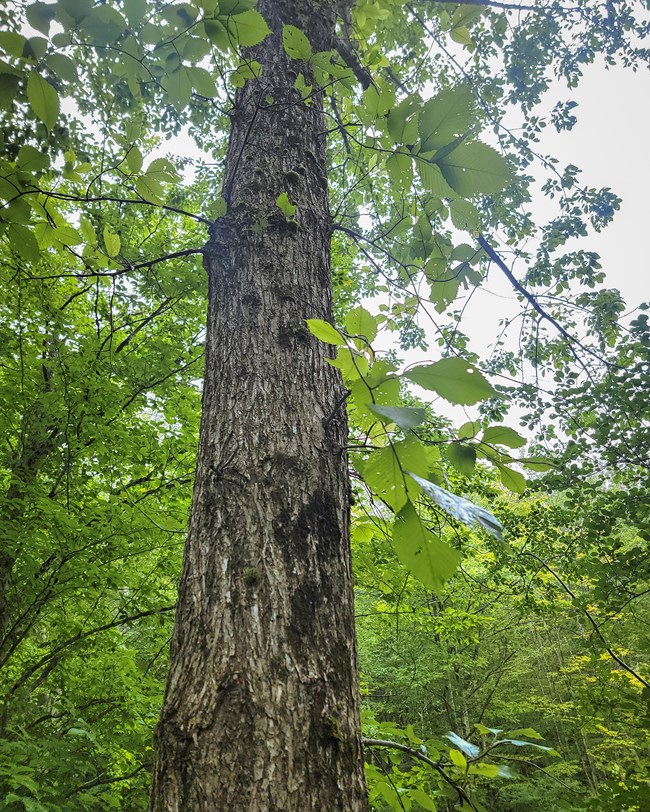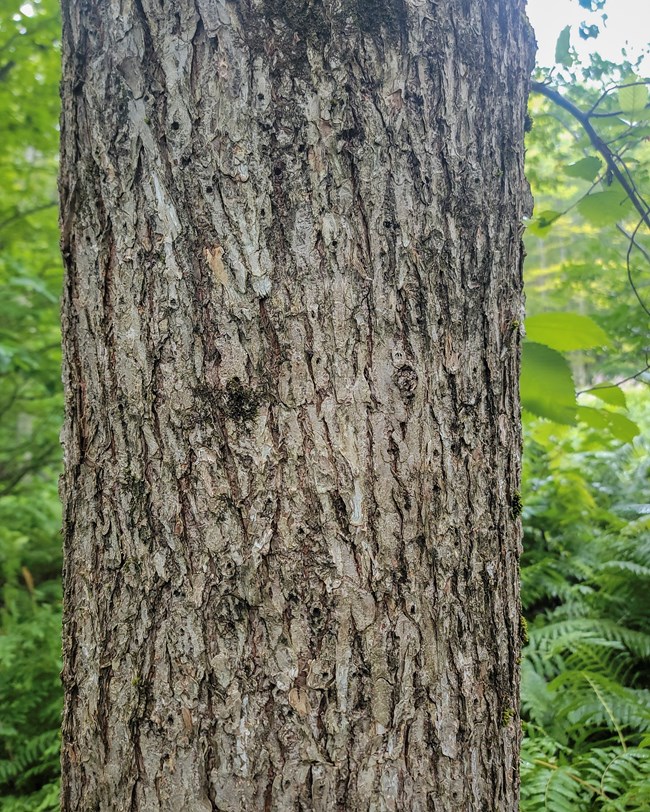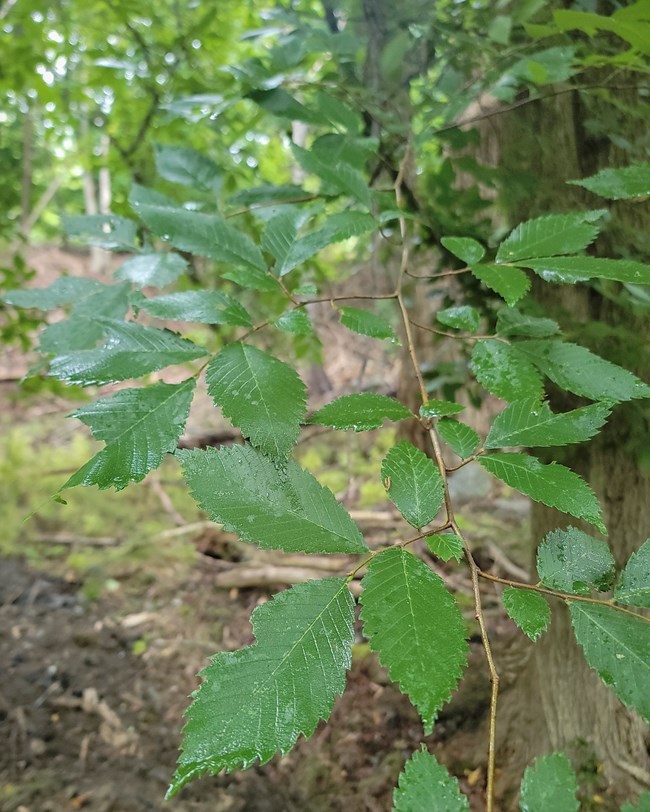Last updated: August 26, 2024
Article
Research Brief: Restoring the American Elm with Genetics
by Marné Quigg

Photo courtesy of Catherine Schmitt, Schoodic Institute
Elm Street is one of the most popular road names in the United States. Historically, these appropriately-named streets were lined with the beautiful American elm (Ulmus americana). However, in the 1930’s the real nightmare on Elm Street began with the spread of the deadly fungus, Dutch elm disease (DED). This devastating disease left Elm Street with no elms, having decimated American elm populations in North America.

Photo courtesy of Catherine Schmitt, Schoodic Institute
The American Elm Story
DED is a fungus that blocks the water transport system of elm trees, often resulting in the death of the tree. The fungus arrived in Ohio in 1930 on a shipment of elm logs for furniture, but was reportedly eradicated. In 1933, it was discovered again in New England and spread over 5,500 square miles by 1940. In the 1960s, a second wave of the disease caused even more trees to die. From the 1930s to the 1980s, an estimated 50-100 million American elm trees died, and this number continues to increase.
The reduction of American elm in urban settings led to a substantial decrease in canopy cover within cities. The loss of a once-prevalent tree in floodplain forests and along water edges profoundly affected ecosystem processes such as erosion, nutrient cycling, and transpiration. Young elms are particularly susceptible to DED, so very few trees survive long enough to flower and reproduce. The last hope of this species is restoration based on the select trees that can withstand this infection.
Disease-resistant American elms are being sold, but they all come from just a few trees that survived. The trees for sale are genetically identical to the original source trees. If restoration is limited to a few identical trees, there will be less variation in the elm genes. If a new disease is introduced and none of the original trees have resistance, then more trees are likely to die. Another problem is that some elms have two sets of chromosomes, while others have four. These trees are unable to reproduce with each other. So, if a tree with two sets of chromosomes is put in an area with only trees that have four sets of chromosomes, they will not be able to reproduce.

Photo courtesy of Catherine Schmitt, Schoodic Institute
Researching the American Elm
I am a graduate student at Northwestern University and the Chicago Botanic Garden in the Plant Biology and Conservation Program studying the genetic diversity of American elm before and after DED. My team of collaborators and I are investigating the genetics of American elms across the species’ range. We hope to determine if DED has resulted in a loss of genetic diversity, which is the variation of genes within a species, and is critical for the long-term survival of that species. Having high genetic diversity ensures a species is resilient and able to withstand new diseases and other stressors such as climate change.
Learning how populations are structured across the landscape will help with restoration efforts, creating a framework to ensure the healthiest and most resilient trees are reintroduced back into the environment. Our collaborators at the U.S. Forest Service are working to ensure they select trees that maximize both genetic diversity and disease resistance, to give American elms a fighting chance.
To answer these questions, the Elm Team and I are collecting American elm leaves from both herbaria (plant museums) and living trees for DNA analysis. To determine if there was a loss of genetic diversity, I have sampled from the herbaria with the most American elm specimens in their collections. Earlier this year, I had the opportunity to visit the four herbaria with the largest elm collections: the Harvard University Herbaria, the New York Botanical Garden Herbarium, the U.S. National Herbarium at the Smithsonian Museum of Natural History, and the University of Kansas Herbarium. My oldest sample is from 1842, decades before DED would reach the U.S. Additionally, we have connected with local collaborators in various national parks, national forests, and state parks across the country to send us samples so we can analyze the current genetic diversity.

Photo courtesy of Catherine Schmitt, Schoodic Institute
Elms in Acadia
Traveling with National Science Foundation undergraduate intern, Therie Moore, I visited Acadia National Park to search for more American elm trees to add to my project in August 2024. This was our last stop on “The Great American Elm Fieldwork Trip” which began at the U.S. National Arboretum in Maryland. We visited several New York State Parks in the Palisades region, then Green Mountain National Forest in Vermont, followed by White Mountain National Forest in New Hampshire, before heading to Katahdin Woods and Waters National Monument in Maine, then finally arriving at Acadia National Park.
In addition to our earlier collecting, I was able to collect samples from seven American elm trees in Acadia. The 1894 botanical inventory of Mount Desert Island lists American elm as rare, but I found several iNaturalist observations of the island, making it a promising location to search. To sample from the trees, I remove three to five leaves from the tree and take some measurements of the tree, so the tree is not harmed in the process. Of the seven trees I sampled from, only two had severe DED, so it is possible there are some resistant trees in Acadia National Park.
Each of these trees has a story. Interestingly, we found three large trees in a perfectly straight line along an old carriage road built around 1899, which is being converted to a new trail. Finding trees growing in a straight line like this is rare, but not impossible. Upon further investigation, historic newspapers reference a shaded walkway constructed along the road in 1914. It is possible these large elm trees were planted around that time. Nestled between those large trees were several smaller American elms. I decided to collect from two of the large trees and one of the smaller trees. Hopefully, we will be able to determine if the small tree is a descendant of the larger trees, and I may be able to tell if the large trees were sourced in another region and brought to Acadia to be planted along the carriage road.
We will begin the next steps of the project with lab work at the Chicago Botanic Garden. I will spend the next few months extracting DNA from approximately 700 different trees before beginning the sequencing process and data analysis. I hope that the results from this study, expected sometime in late 2025, will provide a framework for reintroducing American elms back into natural areas. Hopefully, with strategic restoration, it will be possible to have American elm restored to their historic population numbers with the level of genetic diversity present before DED arrived.
